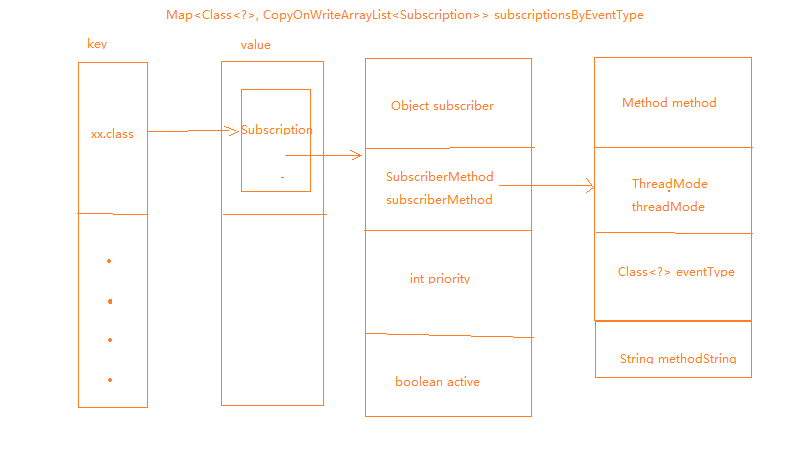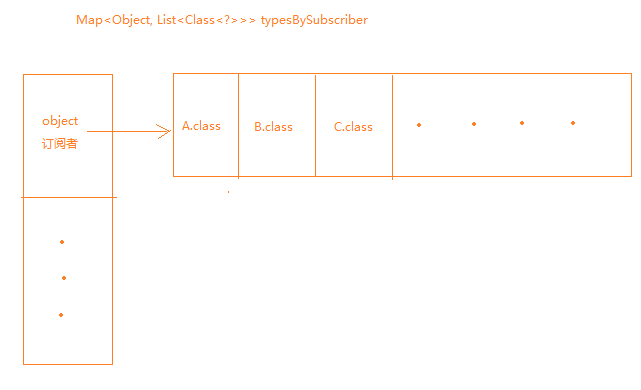持续更新。。。。。。。ing
一、简介
主要功能是替代Intent、Handler、BroadCast在Fragment、Activity、Service、线程之间传递消息。他的最牛逼优点是开销小,代码简洁,解耦代码。当一个Android应用功能越来越多的时候,保证应用的各个部分之间高效的通信将变得越来越困难。
在应用中的多个地方,控件经常需要根据某个状态来更新他们显示的内容。这种场景常见的解决方式就是定义一个接口,需要关注该事件的控件来实现这个接口。然后事件触发的地方来注册/取消注册这些对该事件感兴趣的控件。
githup:https://github.com/greenrobot/EventBus
还有一个类似的项目https://github.com/square/otto
EventBus可以订阅的函数有:
onEvent (Object object )
onEventMainThread (Object object )
onEventBackgroundThread (Object object )
onEventAsync (Object object ) 这四种订阅函数都是使用onEvent开头的,它们的功能稍有不同,在介绍不同之前先介绍两个概念:
告知观察者事件发生时通过EventBus.post函数实现,这个过程叫做事件的发布,观察者被告知事件发生叫做事件的接收,是通过下面的订阅函数实现的。
onEvent:如果使用onEvent作为订阅函数,那么该事件在哪个线程发布出来的,onEvent就会在这个线程中运行,也就是说发布事件和接收事件线程在同一个线程。使用这个方法时,在onEvent方法中不能执行耗时操作,如果执行耗时操作容易导致事件分发延迟。
onEventMainThread:如果使用onEventMainThread作为订阅函数,那么不论事件是在哪个线程中发布出来的,onEventMainThread都会在UI线程中执行,接收事件就会在UI线程中运行,这个在Android中是非常有用的,因为在Android中只能在UI线程中跟新UI,所以在onEvnetMainThread方法中是不能执行耗时操作的。
onEventBackground:如果使用onEventBackgrond作为订阅函数,那么如果事件是在UI线程中发布出来的,那么onEventBackground就会在子线程中运行,如果事件本来就是子线程中发布出来的,那么onEventBackground函数直接在该子线程中执行。
onEventAsync:使用这个函数作为订阅函数,那么无论事件在哪个线程发布,都会创建新的子线程在执行onEventAsync.
二、register方法
public void register(Object subscriber) {
register(subscriber, DEFAULT_METHOD_NAME, false, 0);
}
public void register(Object subscriber, int priority) {
register(subscriber, DEFAULT_METHOD_NAME, false, priority);
}
public void registerSticky(Object subscriber) {
register(subscriber, DEFAULT_METHOD_NAME, true, 0);
}
public void registerSticky(Object subscriber, int priority) {
register(subscriber, DEFAULT_METHOD_NAME, true, priority);
}
本质上就调用了同一个:
在下面的代码中 subscriberMethodFinder.findSubscriberMethods(subscriber.getClass())
的重要作用就是根据订阅者找到该订阅者的订阅函数,然后将封装成SubscriberMethod
简单看看该对象
final class SubscriberMethod {
final Method method;
final ThreadMode threadMode;
/**订阅的方法参数类型*/
final Class<?> eventType;
/** Used for efficient comparison */
String methodString;
...............
...............
}好了,回到重点:
private synchronized void register(Object subscriber, boolean sticky, int priority) {
List<SubscriberMethod> subscriberMethods = subscriberMethodFinder.findSubscriberMethods(subscriber.getClass());
for (SubscriberMethod subscriberMethod : subscriberMethods) {
subscribe(subscriber, subscriberMethod, sticky, priority);
}
} List<SubscriberMethod> findSubscriberMethods(Class<?> subscriberClass) {
//获取订阅者的全限定类名
String key = subscriberClass.getName();
List<SubscriberMethod> subscriberMethods;
synchronized (methodCache) {
//判断是否有缓存,有缓存直接返回缓存
subscriberMethods = methodCache.get(key);
}
//第一次进来subscriberMethods肯定是Null
if (subscriberMethods != null) {
return subscriberMethods;
}
subscriberMethods = new ArrayList<SubscriberMethod>();
Class<?> clazz = subscriberClass;
HashSet<String> eventTypesFound = new HashSet<String>();
StringBuilder methodKeyBuilder = new StringBuilder();
while (clazz != null) {
String name = clazz.getName();
//过滤掉系统类
if (name.startsWith("java.") || name.startsWith("javax.") || name.startsWith("android.")) {
// Skip system classes, this just degrades performance
break;
}
// Starting with EventBus 2.2 we enforced methods to be public (might change with annotations again)
//包括公共、保护、默认(包)访问和私有方法,但不包括继承的方法。当然也包括它所实现接口的方法
Method[] methods = clazz.getDeclaredMethods();
for (Method method : methods) {
String methodName = method.getName();
//找到方法名以onEvent开头的方法
if (methodName.startsWith(ON_EVENT_METHOD_NAME)) {
//获取方法的修饰符,包括public(1), protected(4), private(2), final(16), static(8), abstract(1024) 和interface(512)及Java虚拟机的常数
int modifiers = method.getModifiers();
//方法是PUBLIC的且方法不能是ABSTRACT | STATIC | BRIDGE | SYNTHETIC中的任何一个。
if ((modifiers & Modifier.PUBLIC) != 0 && (modifiers & MODIFIERS_IGNORE) == 0) {
//获取方法参数类型
Class<?>[] parameterTypes = method.getParameterTypes();
//呵呵。。参数只能有一个
if (parameterTypes.length == 1) {
String modifierString = methodName.substring(ON_EVENT_METHOD_NAME.length());
ThreadMode threadMode;
if (modifierString.length() == 0) {
//订阅的方法是onEvent
threadMode = ThreadMode.PostThread;
} else if (modifierString.equals("MainThread")) {
//订阅的方法是onEventMainThread
threadMode = ThreadMode.MainThread;
} else if (modifierString.equals("BackgroundThread")) {
//订阅的方法是onEventBackgroundThread
threadMode = ThreadMode.BackgroundThread;
} else if (modifierString.equals("Async")) {
//订阅的方法是onEventAsync
threadMode = ThreadMode.Async;
} else {
if (skipMethodVerificationForClasses.containsKey(clazz)) {
continue;
} else {
throw new EventBusException("Illegal onEvent method, check for typos: " + method);
}
}
Class<?> eventType = parameterTypes[0];
methodKeyBuilder.setLength(0);
methodKeyBuilder.append(methodName);
methodKeyBuilder.append('>').append(eventType.getName());
String methodKey = methodKeyBuilder.toString();
if (eventTypesFound.add(methodKey)) {
// Only add if not already found in a sub class
//封装一个订阅方法对象,这个对象包含Method对象,threadMode对象,eventType对象
subscriberMethods.add(new SubscriberMethod(method, threadMode, eventType));
}
}
} else if (!skipMethodVerificationForClasses.containsKey(clazz)) {
Log.d(EventBus.TAG, "Skipping method (not public, static or abstract): " + clazz + "."
+ methodName);
}
}
}
//还会遍历父类的订阅函数
clazz = clazz.getSuperclass();
}
//最后加入缓存,第二次使用直接从缓存拿
if (subscriberMethods.isEmpty()) {
throw new EventBusException("Subscriber " + subscriberClass + " has no public methods called "
+ ON_EVENT_METHOD_NAME);
} else {
synchronized (methodCache) {
methodCache.put(key, subscriberMethods);
}
return subscriberMethods;
}
}
找到订阅者订阅的函数列表后,根据每个订阅函数的参数类型(以后就是发布对象)
// Must be called in synchronized block
private void subscribe(Object subscriber, SubscriberMethod subscriberMethod, boolean sticky, int priority) {
//从订阅方法中拿到订阅事件的类型 ,就是onEvent一些列方法里的参数类型
Class<?> eventType = subscriberMethod.eventType;
//通过订阅事件类型,找到所有的订阅(Subscription),订阅中包含了订阅者,订阅方法 、等级
CopyOnWriteArrayList<Subscription> subscriptions = subscriptionsByEventType.get(eventType);
//创建一个新的订阅
Subscription newSubscription = new Subscription(subscriber, subscriberMethod, priority);
if (subscriptions == null) {
//将新建的订阅加入到这个事件类型对应的所有订阅列表
subscriptions = new CopyOnWriteArrayList<Subscription>();
subscriptionsByEventType.put(eventType, subscriptions);
} else {
//如果有订阅列表,检查是否已经加入过
if (subscriptions.contains(newSubscription)) {
throw new EventBusException("Subscriber " + subscriber.getClass() + " already registered to event "
+ eventType);
}
}
// Starting with EventBus 2.2 we enforced methods to be public (might change with annotations again)
// subscriberMethod.method.setAccessible(true);
//根据优先级插入订阅
int size = subscriptions.size();
for (int i = 0; i <= size; i++) {
if (i == size || newSubscription.priority > subscriptions.get(i).priority) {
subscriptions.add(i, newSubscription);
break;
}
}
//将这个订阅事件加入到订阅者的订阅事件列表中
List<Class<?>> subscribedEvents = typesBySubscriber.get(subscriber);
if (subscribedEvents == null) {
subscribedEvents = new ArrayList<Class<?>>();
typesBySubscriber.put(subscriber, subscribedEvents);
}
subscribedEvents.add(eventType);
if (sticky) {
if (eventInheritance) {
// Existing sticky events of all subclasses of eventType have to be considered.
// Note: Iterating over all events may be inefficient with lots of sticky events,
// thus data structure should be changed to allow a more efficient lookup
// (e.g. an additional map storing sub classes of super classes: Class -> List<Class>).
Set<Map.Entry<Class<?>, Object>> entries = stickyEvents.entrySet();
for (Map.Entry<Class<?>, Object> entry : entries) {
Class<?> candidateEventType = entry.getKey();
if (eventType.isAssignableFrom(candidateEventType)) {
Object stickyEvent = entry.getValue();
checkPostStickyEventToSubscription(newSubscription, stickyEvent);
}
}
} else {
Object stickyEvent = stickyEvents.get(eventType);
checkPostStickyEventToSubscription(newSubscription, stickyEvent);
}
}
}先不讨论sticky
看得出该函数主要干了2件事(不讨论sticky),
1.根据发布类型,建立一个Subscription订阅列表,看得出Subscription封装了订阅者、SubscriberMethod和订阅的等级(数字越大,订阅越靠前);
2.根据订阅者,建立一个订阅的事件类型列表。
final class Subscription {
/** 订阅者*/
final Object subscriber;
/**封装 的订阅方法*/
final SubscriberMethod subscriberMethod;
/** 等级*/
final int priority;
/**
* 只要unregister(Object)方法被调用,active就会变成false
* Becomes false as soon as {@link EventBus#unregister(Object)} is called, which is checked by queued event delivery
* {@link EventBus#invokeSubscriber(PendingPost)} to prevent race conditions.
*/
volatile boolean active;
......................
......................
}
到此regist方法分析完。。注册完后就可以发布了。
三、POST方法
public void post(Object event)
public void postSticky(Object event) 先看post(Ocject event)
/** For ThreadLocal, much faster to set (and get multiple values). */
final static class PostingThreadState {
//这里的Object是什么?就是你要发布时的event(简单的说就是一个对象)
final List<Object> eventQueue = new ArrayList<Object>();
boolean isPosting;
boolean isMainThread;
Subscription subscription;
Object event;
boolean canceled;
}
//任何地方都可以调用
/** Posts the given event to the event bus. */
public void post(Object event) {
PostingThreadState postingState = currentPostingThreadState.get();
List<Object> eventQueue = postingState.eventQueue;
//将事件放入队列
eventQueue.add(event);
if (!postingState.isPosting) {
postingState.isMainThread = Looper.getMainLooper() == Looper.myLooper();
postingState.isPosting = true;
if (postingState.canceled) {
throw new EventBusException("Internal error. Abort state was not reset");
}
try {
while (!eventQueue.isEmpty()) {
//分发事件 ,直到列表里没有消息了
postSingleEvent(eventQueue.remove(0), postingState);
}
} finally {
postingState.isPosting = false;
postingState.isMainThread = false;
}
}
}
private void postSingleEvent(Object event, PostingThreadState postingState) throws Error {
//获取发布 的对象类型
Class<?> eventClass = event.getClass();
boolean subscriptionFound = false;
if (eventInheritance) {
//找到eventClass对应的事件,包含父类对应的事件和接口对应的事件
List<Class<?>> eventTypes = lookupAllEventTypes(eventClass);
int countTypes = eventTypes.size();
for (int h = 0; h < countTypes; h++) {
Class<?> clazz = eventTypes.get(h);
subscriptionFound |= postSingleEventForEventType(event, postingState, clazz);
}
} else {
subscriptionFound = postSingleEventForEventType(event, postingState, eventClass);
}
if (!subscriptionFound) {
if (logNoSubscriberMessages) {
Log.d(TAG, "No subscribers registered for event " + eventClass);
}
if (sendNoSubscriberEvent && eventClass != NoSubscriberEvent.class &&
eventClass != SubscriberExceptionEvent.class) {
post(new NoSubscriberEvent(this, event));
}
}
}
private boolean postSingleEventForEventType(Object event, PostingThreadState postingState, Class<?> eventClass) {
CopyOnWriteArrayList<Subscription> subscriptions;
synchronized (this) {
//根据订阅的参数类型获取订阅列表
subscriptions = subscriptionsByEventType.get(eventClass);
}
if (subscriptions != null && !subscriptions.isEmpty()) {
for (Subscription subscription : subscriptions) {
//准备好要发布的对象
postingState.event = event;
//前面已经根据对象类型找到了与之关联的订阅列表,所以在循环里逐个找到订阅
postingState.subscription = subscription;
boolean aborted = false;
try {
//要发布了。。。
postToSubscription(subscription, event, postingState.isMainThread);
aborted = postingState.canceled;
} finally {
postingState.event = null;
postingState.subscription = null;
postingState.canceled = false;
}
if (aborted) {
break;
}
}
return true;
}
return false;
}
private void postToSubscription(Subscription subscription, Object event, boolean isMainThread) {
//第一个参数就是传入的订阅,第二个参数就是对于的分发对象,第三个参数非常关键:是否在主线程
switch (subscription.subscriberMethod.threadMode) {
//当前页面直接发布
case PostThread:
//直接在本线程中调用订阅函数
invokeSubscriber(subscription, event);
break;
//要发布到主线程
case MainThread:
if (isMainThread) {
//如果直接在主线程,那么直接在本现场中调用订阅函数
invokeSubscriber(subscription, event);
} else {
//如果不在主线程,那么通过handler实现在主线程中执行
mainThreadPoster.enqueue(subscription, event);
}
break;
//要发布到后台线程
case BackgroundThread:
if (isMainThread) {
//如果当前是主线程,创建一个runnable丢入线程池中
backgroundPoster.enqueue(subscription, event);
} else {
//如果子线程,则直接调用
invokeSubscriber(subscription, event);
}
break;
case Async:
//不论什么线程,直接丢入线程池
asyncPoster.enqueue(subscription, event);
break;
default:
throw new IllegalStateException("Unknown thread mode: " + subscription.subscriberMethod.threadMode);
}
}
五、
四个参数
subscriber 是我们扫描类的对象,也就是我们代码中常见的this;
methodName 这个是写死的:“onEvent”,用于确定扫描什么开头的方法,可见我们的类中都是以这个开头。
sticky 这个参数,解释源码的时候解释,暂时不用管
priority 优先级,优先级越高,在调用的时候会越先调用。
List<SubscriberMethod> subscriberMethods = subscriberMethodFinder.findSubscriberMethods(subscriber.getClass());
实例:“设置壁纸”
EventBus规定onEvent方法固定作为订阅者接受事件的方法,应该是参考了“约定优于配置”思想。
-
定义EventModel,作为组件间通信传递数据的载体
public class WallpaperEvent {
private Drawable wallpaper;
public WallpaperEvent(Drawable wallpaper) {
this.wallpaper = wallpaper;
}
public Drawable getWallpaper() {
return wallpaper;
}
public void setWallpaper(Drawable wallpaper) {
this.wallpaper = wallpaper;
}
}-
定义订阅者,最重要的是onEvent方法
public class BaseActivity extends Activity {
@Override
protected void onCreate(Bundle savedInstanceState) {
super.onCreate(savedInstanceState);
EventBus.getDefault().register(this);
initWallpaper();
}
@Override
protected void onDestroy() {
super.onDestroy();
EventBus.getDefault().unregister(this);
}
public void onEvent(WallpaperEvent wallpaperEvent) {
// AppConfig.sWallpaperDrawable as a global static var
AppConfig.sWallpaperDrawable = wallpaperEvent.getWallpaper();
initWallpaper();
}
private void initWallpaper() {
// support custom setting the wallpaper
// 根据AppConfig.sWallpaperDrawable,默认值等设置当前Activity的背景壁纸
// ...
}
}-
通过post()方法在任何地方发布消息(壁纸,准确的说是WallpaperEvent)给所有的BaseActivity子类,举个例子:
private void downloadWallpapper(String src) {
ImageLoader.getInstance().loadImage(src, new SimpleImageLoadingListener() {
@Override
public void onLoadingComplete(String imageUri, View view, Bitmap loadedImage) {
BitmapDrawable wallpaper = new BitmapDrawable(loadedImage);
// presist the image url for cache
saveWallpaper(imageUri);
// notify all base activity to update wallpaper
EventBus.getDefault().post(new WallpaperEvent(wallpaper));
Toast.makeText(WallpapeEventBusrActivity.this,
R.string.download_wallpaper_success,
Toast.LENGTH_SHORT).show();
}
@Override
public void onLoadingFailed(String imageUri, View view, FailReason failReason) {
Toast.makeText(WallpaperActivity.this,
R.string.download_wallpaper_fail,
Toast.LENGTH_SHORT).show();
}
});
}// 在任何地方调用下面的方法,即可动态全局实现壁纸设置功能
EventBus.getDefault().post(new WallpaperEvent(wallpaper));
参考:http://blog.csdn.net/harvic880925/article/details/40787203
http://blog.csdn.net/yuanzeyao/article/details/38174537
http://www.2cto.com/kf/201411/350935.html























 837
837











 被折叠的 条评论
为什么被折叠?
被折叠的 条评论
为什么被折叠?








